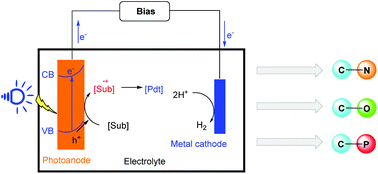Recent advances in photoelectrochemical cells (PECs) for organic synthesis
Abstract
Photoelectrochemical cells (PECs) have emerged as an environmentally friendly tool for fuel production, conversion of carbon dioxide, water splitting, and pollutant degradation in the past few years. Although PECs show advantages in these areas, their application in organic synthesis has just begun. Recently, oxidation, C–H functionalization and cross-coupling have been successfully achieved in PECs by the use of an oxidizing photoanode, such as BiVO4 or WO3, for the construction of C–N, C–O and C–P bonds. This highlight article focuses on the application of PECs in organic synthesis reactions and their reaction mechanisms, with a special emphasis on enantioselective conversions.

- This article is part of the themed collection: 2020 Organic Chemistry Frontiers Review-type Articles


 Please wait while we load your content...
Please wait while we load your content...